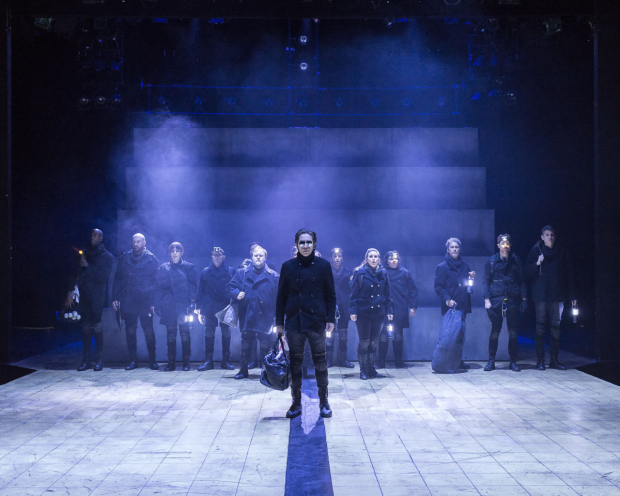Henry V Is Shakespeare's Royal Rebel With a Cause
A Noise Within presents the final play in the Bard’s ”Henry” trilogy.

(© Craig Schwartz)
A war pageant, Shakespeare's Henry V portrays a king evolving into a formidable force. Codirectors Julia Rodriguez-Elliott and Geoff Elliott incorporate music, pomp, and studied performances to elevate the text and keep audiences engaged. Some directorial choices in this A Noise Within production, though, wound Act 1's momentum. However, a triumphant Act 2 leaves audiences rousing for the English crown.
Shakespeare’s protagonist has a long-stretching character arc that spreads through three plays — Henry IV, Part I, Henry IV, Part II and Henry V. In this play, having risen to the English throne after the death of his father, Henry (Rafael Goldstein) engages in war with neighboring France, a country he believes he has an inalienable right to rule. The dauphin of France insults Henry, egging him on by sending the ruler a bag of tennis balls. At first, France has the upper hand and England suffers horrific losses. Henry disguises himself as a soldier and, upon learning that his army's morale has been beaten down, realizes he must find a way to renew their spirits. At the Battle of Agincourt, Henry rallies his troops with a rousing speech and leads his army to combat.
In the earlier plays, the prince, known as Hal to his oafish but loyal friend Falstaff, rides a wave of debauchery that angers his father and frustrates the court. By the end of Henry IV, Part II, the new king has proven his valor through a genuine heroic transformation. But here, directors Rodriguez-Elliott and Elliott appear to want audiences to feel the character's entire arc through the trilogy purely in the text of this one play, coloring Henry's behavior in the first act as petulant and sullen. He arrives with mirrored sunglasses and a rock-star attitude that makes his conspirators appear justified. It leaves Act 1 without a hero and with Henry seeming snide when he should feel commanding. Act 2 is much more absorbing, with the protagonist exemplifying leadership savvy and compassion.
Rodriguez-Elliott and Elliott stage the epic battle scenes like fierce explosions with fantastic fight choreography by Kenneth R. Merckx Jr., Collin Bressie, and Marc Leclerc. The stirring St. Crispin's Day speech is a particular high point. Small scenes, like Henry's tender romance with Princess Katherine (Erika Soto), or Henry's masquerade and eventual reveal to his soldier Williams (Stephen Weingartner), are especially impactful moments that demonstrate Henry's gentleness towards his future queen and his playfulness and relatability towards his crew. The final scene, where Henry and Katherine spell out the future of England, is haunting. One misstep in the production comes during the public hanging scene, when an actor's harness is so glaringly obvious that it takes the audience out of what should have been a heartbreaking choice for the king.
Goldstein finds humanity in his role and illustrates the king's growing inner strength. Boyish, defiant, and eventually victorious, he makes the audience wish they were able to see him perform the role in all three plays. Frederick Stuart is appropriately harried as the French ruler being backed against a wall. Kasey Mahaffy turns the dauphin into a belittling bully daring a justifiable comeuppance. As the demure but self-assured Katherine, Erika Soto proves herself to be formidable in her scenes with Goldstein. As Queen Isabel, Cassandra Marie Murphy's melodic voice is a treat, singing original melodies by Robert Oriol based on the Latin hymns in Shakespeare's text.
Rodriguez-Elliott and Elliott dress the actors in modern clothing; however, they have not firmly drawn correlations between today’s events and those in the play. Instead, with its mostly bare stage, the play’s setting is more abstract. Angela Balogh Calin's costumes mix modern-day dress with the metallic armor of the medieval era. Frederica Nascimento's slim set of movable stairs allows audiences to focus on the cast. Ken Booth's lighting design is a smoke-filled dank world of death and mutilation. Percussionist Tim Curle sets the play's rhythm simulating the march to demolition.
Directors Rodriguez-Elliott and Elliott have removed text and altered Henry V down to a fast-paced 120 minutes. Their calculations turn Act 2 into a rollercoaster ride, but Act 1's portrayal of the king as antagonistic and almost as unlikable as his enemy, the dauphin, makes him appear unjust and unqualified, leaving the audience without a ruler in which to root for until Act 2. While flaws do make a leader human, they can also lead to his downfall.









